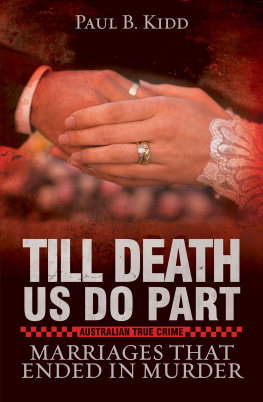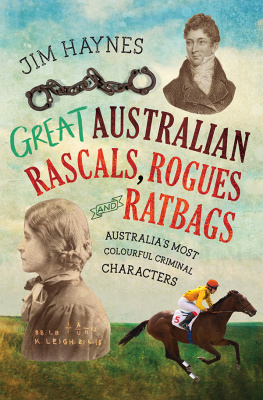The Australian Crime File 2
More Stories from Australias Best True Crime Collection
Paul B. Kidd
To Tania.
My partner and the best assistant a bloke could have.
And, as always, for my son, Benny.
Introduction
In light of the extraordinary success of The Australian Crime File I guess its only logical that I would write a Crime File 2 . After all, writing books is a big part of what I do for a living. And, lets face it, it wasnt as if the chapters were hard to put together, given that I read a Crime File one that I have written during the week on the Weekend Breakfast Show , the show George Moore and I broadcast from 6am until midday on Saturday and Sunday on Sydneys Radio 2UE.
Having said that, I would like to point out that many of the stories in this book are a little more out of left-field than those that appeared in the first Crime File . That edition dealt mainly with Australias better-known crimes, rather than the unusual or the bizarre. While a few of our more higher-profile cases Lindy Chamberlain, Alan Bond and the Port Arthur Massacre come to mind are in this book, you will also find many other yarns from our rich, unlawful history, a history that makes us one of the more unusual nations in the world.
While, sadly, it would have been impossible to write a Crime File 2 without the cases of multiple, serial, mass and child murder, this book also looks at a huge variety of lesser crimes that make up this genre. You will read about illegal SP bookies, bent police commissioners and cops, the day the police went on strike, our first political assassination attempt, the worlds best escapologists, bent entrepreneurs, Australias leading abortionist and underworld murders. They are all in here. Plus lots of fascinating historical crimes.
A Crime File that I present on air is usually about 1200 words long and takes about seven minutes to read. Lots of the stories included here are the length I wrote them for radio, and exactly as I read them out on air. Others you will find are a little longer and, in some cases, a lot longer. I have gone to the trouble to re-write these as I believe that they are interesting enough to bring them to you in much more detail. The persecution of Lindy Chamberlain is such an example.
I have also included several chapters that have arisen out of my own personal experience and that I would like to share with you. The opening chapter tells how I supported a very brave man named Sandy MacGregor who visited a jail to forgive the man who had murdered his (Sandys) three daughters. In The Deep-Sea Contract I tell of my near-death experience at the hands of a marauding mako shark and a gun-totin gangsters minder both at the same time. And A Trout to Die For is the unusual story told to me about a couple of harmless crooks who try to outsmart the bigger crooks, with disastrous results. Fact or urban legend? Youll have to decide that one for yourself.
Which brings us to my masterpiece, if I dont mind saying so myself Celluloid Serial Killers: The History of Serial Killers in the Movies . Years in the researching, it tells the history of serial killers on the screen throughout the ages and, as a bonus, I give my list of the top ten serial killer movies in history. Given that serial killer movies are either factual ( The Boston Strangler , Ten Rillington Place ), a mixture of fact and fiction ( Wolf Creek , Dirty Harry ) or just pure fiction ( Se7en , Manhunter ), theres something in here for everyone even if its just to assist you to make up your own list of favourites and compare them with mine, or to help you win a bet at the pub.
Paul B. Kidd
'I Forgave My Daughters' Killer'
In 2001 Sandy MacGregor went to prison to confront the man who shotgun-blasted his three daughters to death. Author Paul B. Kidd was there as the drama unfolded.
As I sat waiting to meet the man who murdered my children, I really didnt know what my reaction towards him would be, says Sandy MacGregor. I was incredibly nervous and uptight. Not shaking or anything like that. It was all on the inside.
In all of the months I had spent preparing myself for this moment I had never kidded myself that it was going to be easy. But I had imagined, or rather hoped, that it would be a lot easier than this. But now that it was actually happening I was apprehensive of the outcome, frightened of what I might do.
I could have stopped it then and no one would have thought any the less of me, he says. But there was no turning back now. I had to meet this man and forgive him for what he had done. Not for him, but for me. And then I could be completely at peace with myself and get on with my life.
As he relaxes in the loungeroom of his Sydney home, Sandy MacGregor is the embodiment of what he teaches: how to manage your life through the powers of your own mind. He sits surrounded by photos of his family his deceased daughters, their elder brother Andrew, now 36, his second wife Sandra and their family of Ian, 17 and Lara, 19. And this tall, gentle man speaks candidly about the murder of his daughters Lexie, 16, and twins Jenny and Kirsty, 19, and their 19-year-old girlfriend and how he came to forgive the man who so callously took his loved ones from him.
The early hours of 24 January 1987, are deep-etched in Sandy MacGregors memory forever. I was re-married with a young family and my daughters lived with their mother nearby, he recalls. The kids and I were extremely close and I was in frequent contact with them. At 2am there was a loud knocking on the door and I answered it to two policemen, who ushered me through to the loungeroom and sat me down. They said they had some terrible news. They told me that my three daughters and a friend had been killed in their mothers home.
My reaction was disbelief. My daughters couldnt be dead. Only the night before I had called to wish Lexie a happy birthday and talked about the camping trip they were going on the following day for the Australia Day long weekend. It had to be a mistake.
As they drove Sandy to the scene, the officers explained that a male friend who was going on the camping trip had called several times during the evening and when there was no answer, although the lights were on, he had climbed through a window at 1.10am to find the carnage.
When I arrived I embraced my ex-wife Beverley, who had arrived home to the chaos from a friends wedding celebration, and we sobbed uncontrollably, he says. Beverley wanted to go inside and see what had happened to her daughters but the police took me aside and explained that the girls had been blown away with a shotgun.
They apologised for being so graphic but said that they had to tell me this as due to the horrific nature of the crimes they wanted my support to keep Beverley from going inside. They said that it was best that we remember our children as they were. Neither of us went inside. I am glad that I didnt.
The following day police arrested unemployed student Richard Henry Lawson Maddrell, 27, as he sat on a cliff top contemplating suicide. He had thrown the shotgun in the ocean. A diagnosed paranoid schizophrenic and high on a cocktail of drugs at the time of the killings, Maddrell had met Jenny MacGregor when she was a student at Wollongong University, 100 kilometres south of Sydney. Maddrell had become infatuated, but over the previous 12 months she had rejected his advances.
Maddrell told police that he had gone to Jenny MacGregors house at 9.30 that night with a loaded shotgun. After she answered the door, he marched her at gunpoint into the loungeroom where the other girls were watching television and allegedly said to her, You dont know how much you have hurt me and screwed me up, but I still love you, before shooting her in the head at point-blank range. Maddrell then killed the other three girls with five more shots to their heads after stopping to re-load twice.














